Butterfly bush care and growing guide: expert tips on growing buddleja
Grow a butterfly bush for a stunning summertime display that is easy to maintain, wildlife-friendly and pretty as a picture
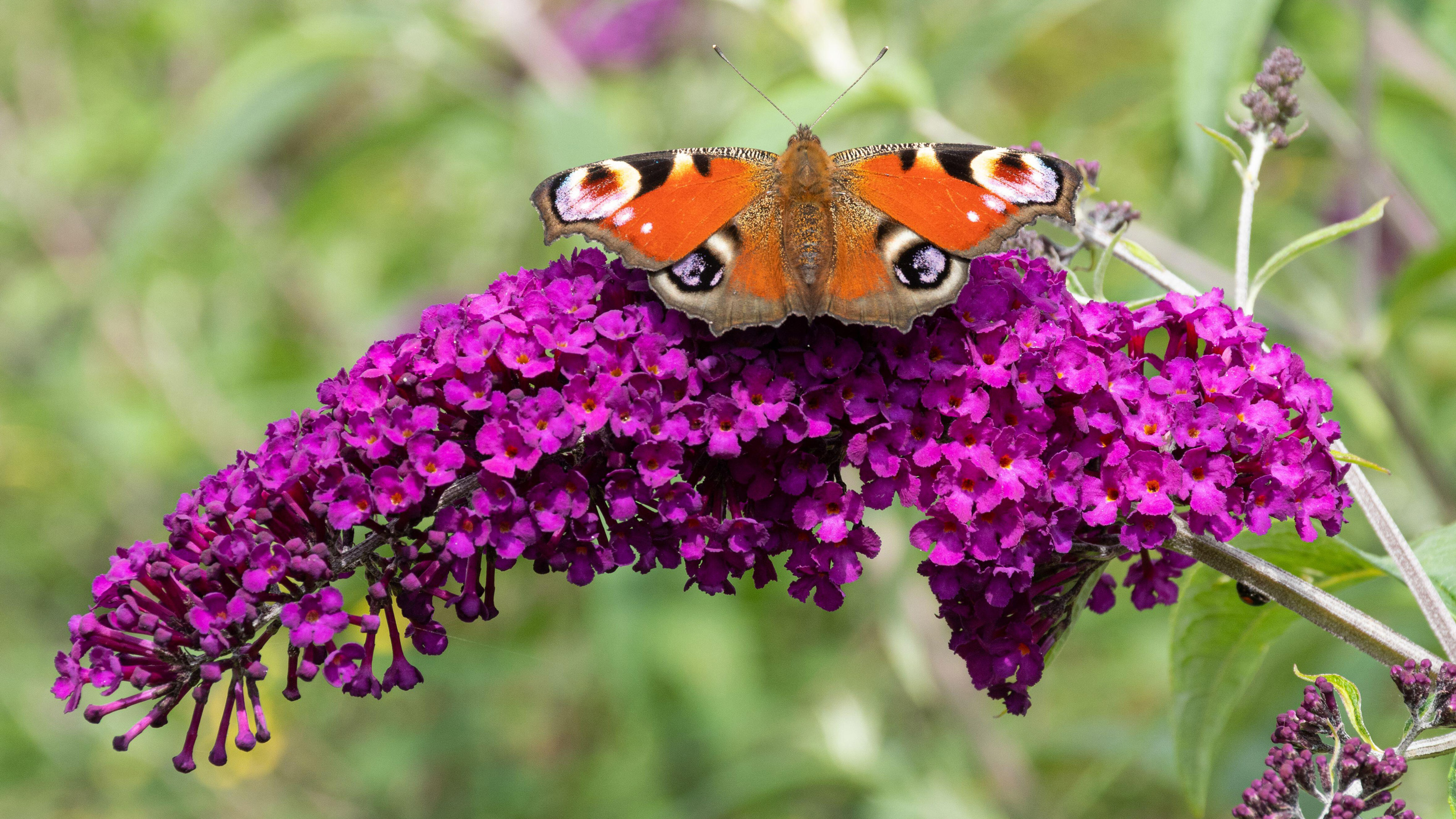

Butterfly bush is a strong growing, deciduous flowering shrub producing large colorful cones of flowers in summer and fall. Each flowering head is made up of a huge number of tiny individual flowers that produce large quantities of nectar and so are popular with hummingbirds, butterflies and many other insects.
Buddlejas are tolerant summer-flowering shrubs, easy to grow and easy to prune. And while old varieties can produce a heavy crop of seeds which help the plants become invasive in mild areas, in recent years safe-to-plant modern varieties have been developed that produce no seeds at all.
'Butterfly bushes are a great addition to almost any garden, attracting butterflies, hummingbirds, and beneficial pollinators in droves,' says the experts at Wayside Gardens. 'Also known as buddlejas, these are large, dense bushes featuring big, majestic flower spikes that bloom in intense hues of pink, orange, red, and purple throughout the summer. Several cultivars have great drought-tolerance, making them the perfect low-maintenance plant for the back of a mixed border planting.'
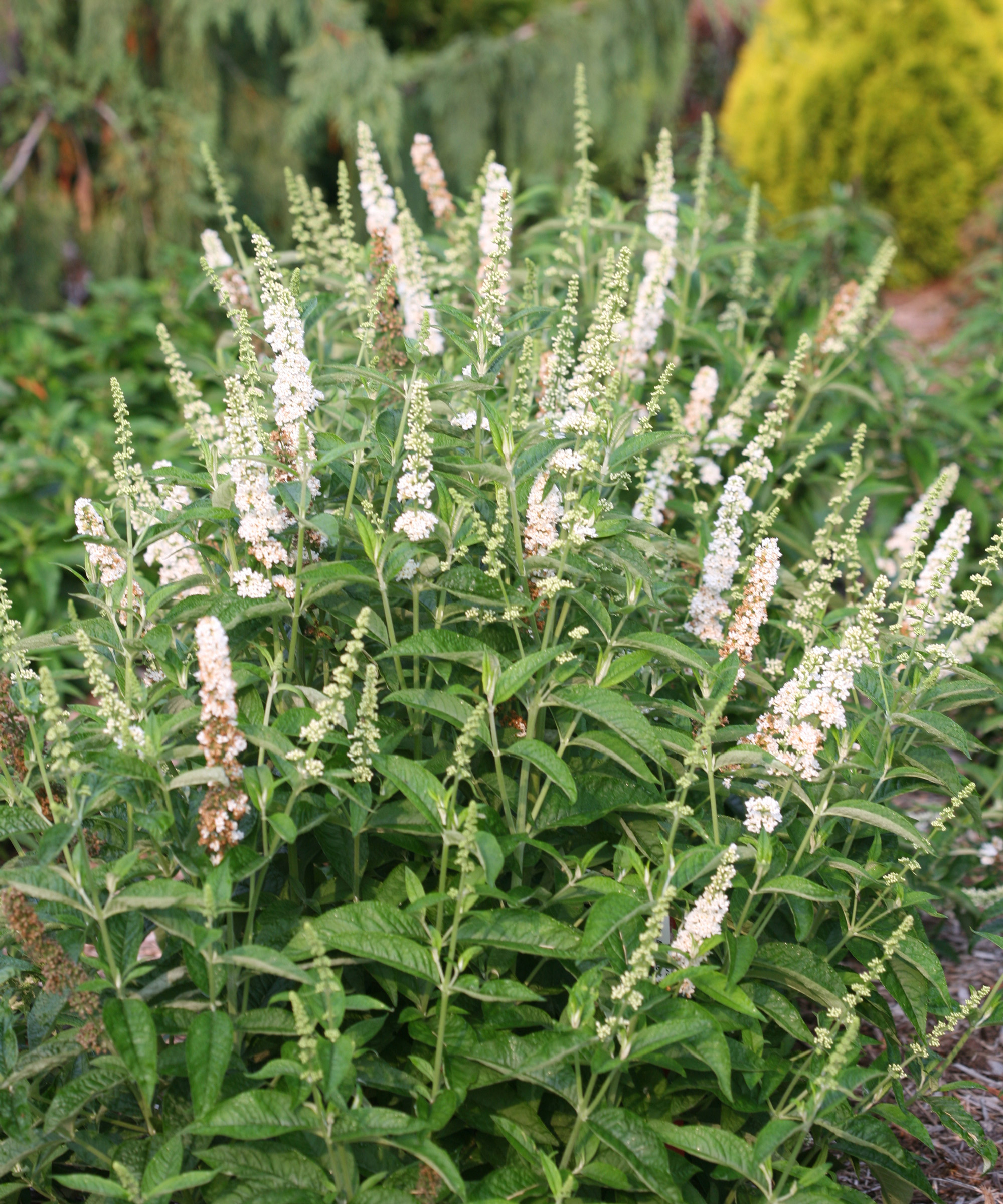
There’s a good range of modern butterfly bush varieties to choose from – look out for the Miss Series, including 'Miss Pearl White'
The different kinds of butterfly bush
The butterfly bush is a group of shrubs consisting of over 140 species of flowering plants, in differing shapes and sizes. Some (like ‘Miss Ruby’ and ‘Blue Chip’) are compact and only get to 2-6ft (60cm-2m) tall, while others (such as ‘Blue Horizon’ and ‘Dartmouth’) grow as tall as 13-16ft (4-5m) high over 10 years.
Depending on your color preference, there are myriad hues from bright white flowers through to pastel blue, pink and purple flowers and deepest magenta blooms.
However, while there are plenty of varieties to choose from, there are two main kinds of buddleja:
- Old-fashioned butterfly bush: Older varieties tend to be the tallest and most vigorous. They are often prolific flowerers and produce a lot of nectar to feed pollinating insects. They can also produce a huge number of seeds. Varieties in this group include the English Butterfly Series and the shorter Buzz Series, as well as ‘Black Knight’ and ‘Royal Red’.
- Modern butterfly bush: Modern varieties have mostly been developed in North America to produce neater, more compact growth for small backyards and patios. Many modern varieties produce no seed and are not invasive. Modern varieties include the dwarf Lo & Behold Series and the taller Miss Series, plus the Flutterby Series (pictured).
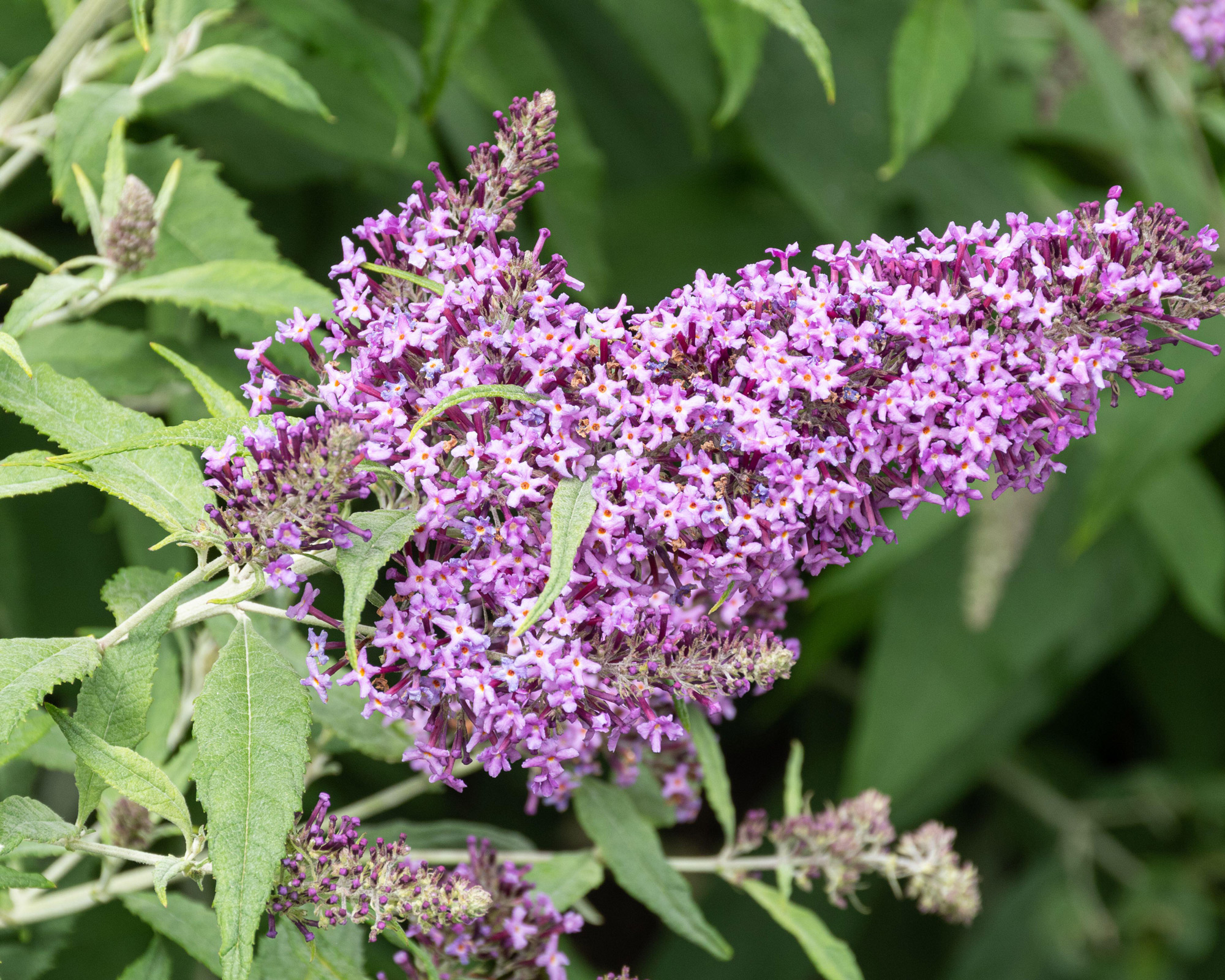
Buddleja ‘Flutterby Pink’ is a modern variety of butterfly bush
How to choose the right butterfly bush for your yard
If you're interested in growing a butterfly garden, buddleja makes a great addition to your planting plans, but there are a few things to consider.
First, decide if you need a modern, non-invasive type in your area. Seedlings of old fashioned invasive types will usually be killed by winter frost in zones 5 and 6, so it is safe to plant them. In zones 7 to 9, plants that sprout from seed fallen from your old fashioned varieties will survive and can spread quickly – so choose a non-invasive variety.
Then consider the final size. The Lo & Behold series is ideal for patio containers, plants in the Miss Series are taller and more suitable for mixed garden borders, shrub borders and as specimens.
When and where to plant a butterfly bush
Butterfly bushes need at least six hours of sun each day, all day sun is preferable, and they will grow thin and spindly and flower very poorly under trees. Any reasonable, well-drained soil suits butterfly bushes but they appreciate thorough preparation before planting, so amend the soil with garden compost or bagged planting mix.
Plant butterfly bushes in spring or early to mid-summer, soaking the root ball in a bucket of water while you prepare the site. After planting, mulch with of bark chips or other weed free material to prevent weeds growing.
The experts at Proven Winners remind us to avoid fall planting. 'Because butterfly bush may get a bit of winter damage in cold climates, it’s best to give them as long a time as possible to get established before they face the challenges of the cold, wet season. In USDA zones 5 and 6 especially, keep butterfly bush planting time to spring through mid-summer so the plants have ample opportunity to develop a good root system to sustain them through winter.'
If you're including them in your summer container ideas, choose a well-drained planting mix and stand the container on pot feet to lift the pot just off the ground and allow surplus moisture to drain away quickly – otherwise the roots will rot.
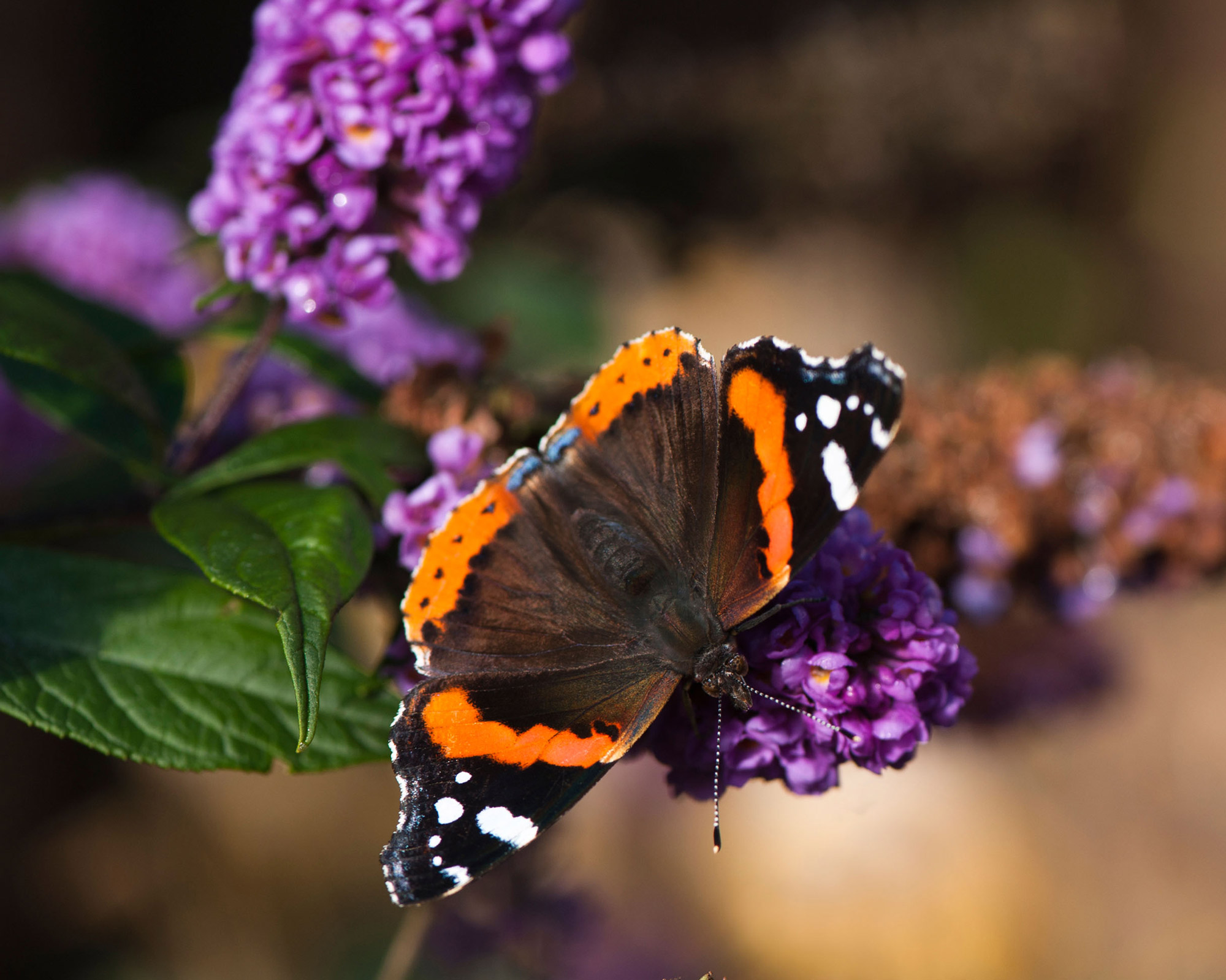
Lo & Behold butterfly bush is a dwarf variety and is suitable for containers and patios
How to plant a butterfly bush
There are no complicated tricks when you plant a butterfly bush, but a few planting principles will ensure the healthiest, bushiest and most wildlife-friendly displays.
- Make sure you get rid of weeds and large stones before you plant your butterfly bush.
- Check the planting hole has a diameter approximately two-three times the size of the rootball. Soak the root ball in a bucket of water prior to planting.
- When planting, ensure that the tops of the roots are roughly level with the surface of the soil.
- After planting, mulching with 2-3in (5-7.5cm) of bark chips or other weed-free material will conserve soil moisture and prevent weed growth.
- A gentle watering here and there is fine, but these plants won’t need as much hydration as other plants in your garden, and many varieties are good drought-tolerant plants once established.
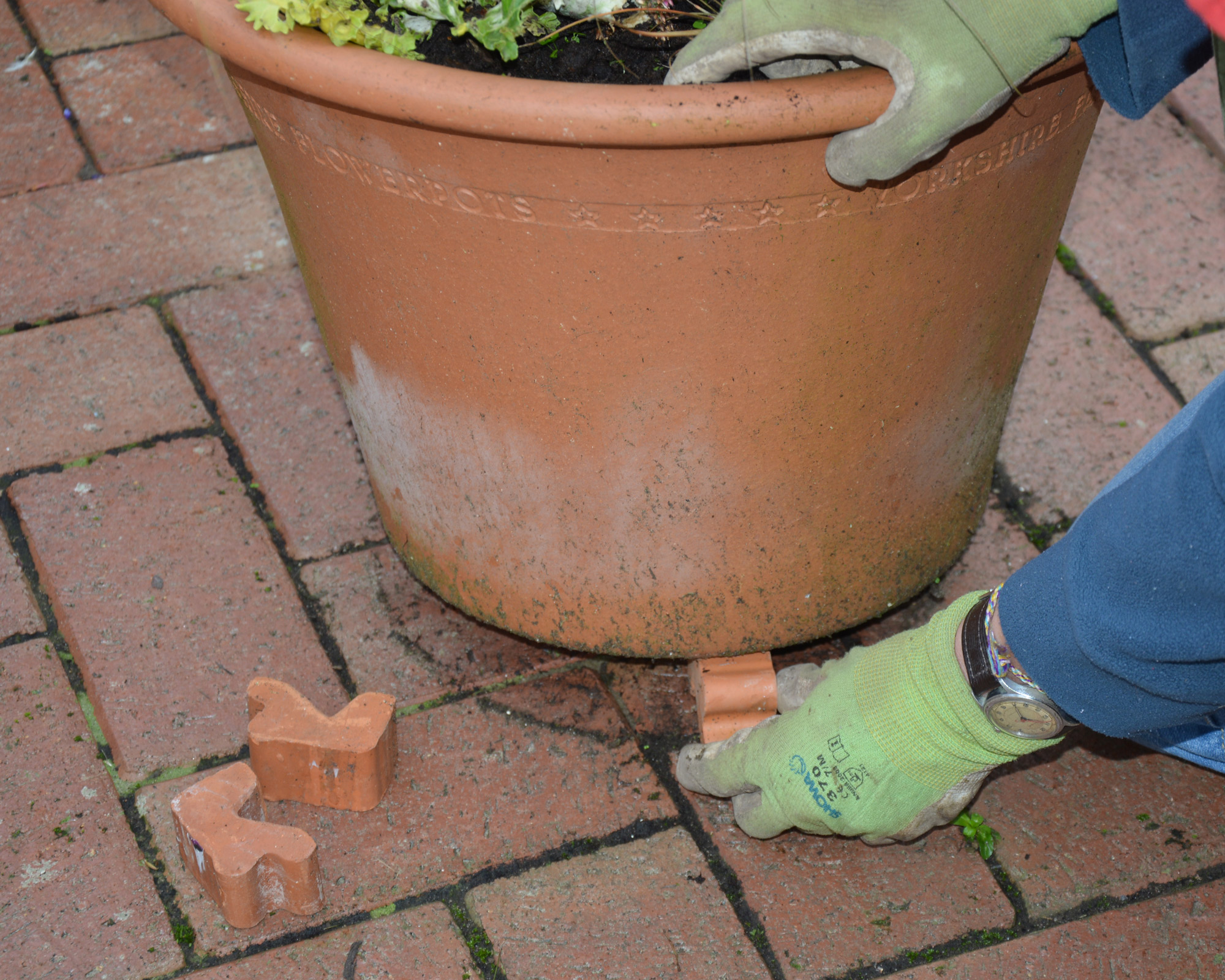
When growing in containers, allow excess water to drain by adding pot feet
Can I grow a butterfly bush in a pot?
The butterfly bush makes an excellent choice for colorful container gardening ideas, as long as you pick a suitable variety and look after it in the right way.
Choose only modern varieties that remain small and will not drop seeds that will sprout between the cracks in your paving. Varieties in the Lo & Behold Series are ideal. Buddleja such as ‘Petite Blue Heaven’, ‘Nanho Blue’, ‘Summer Bird Snow’ and ‘Buzz’ are also prime candidates for your garden planter ideas.
Choose a large container, 18-24in (45-60cm) across, and place it in a sunny position on three pot feet to ensure good drainage. Part fill with fresh, damp, potting soil and set the plant in place so that its compost is about 1in (2.5cm) below the rim of the container.
Add more potting soil and firm well around the buddleja roots leaving a level finish. Mulch with gravel or bark chips then water in well with a liquid feed.
Keep moist all summer, deadheading flowers regularly, then, in colder areas, move the pot to a sheltered pace for the winter. Prune in spring, then move back to a sunny site.
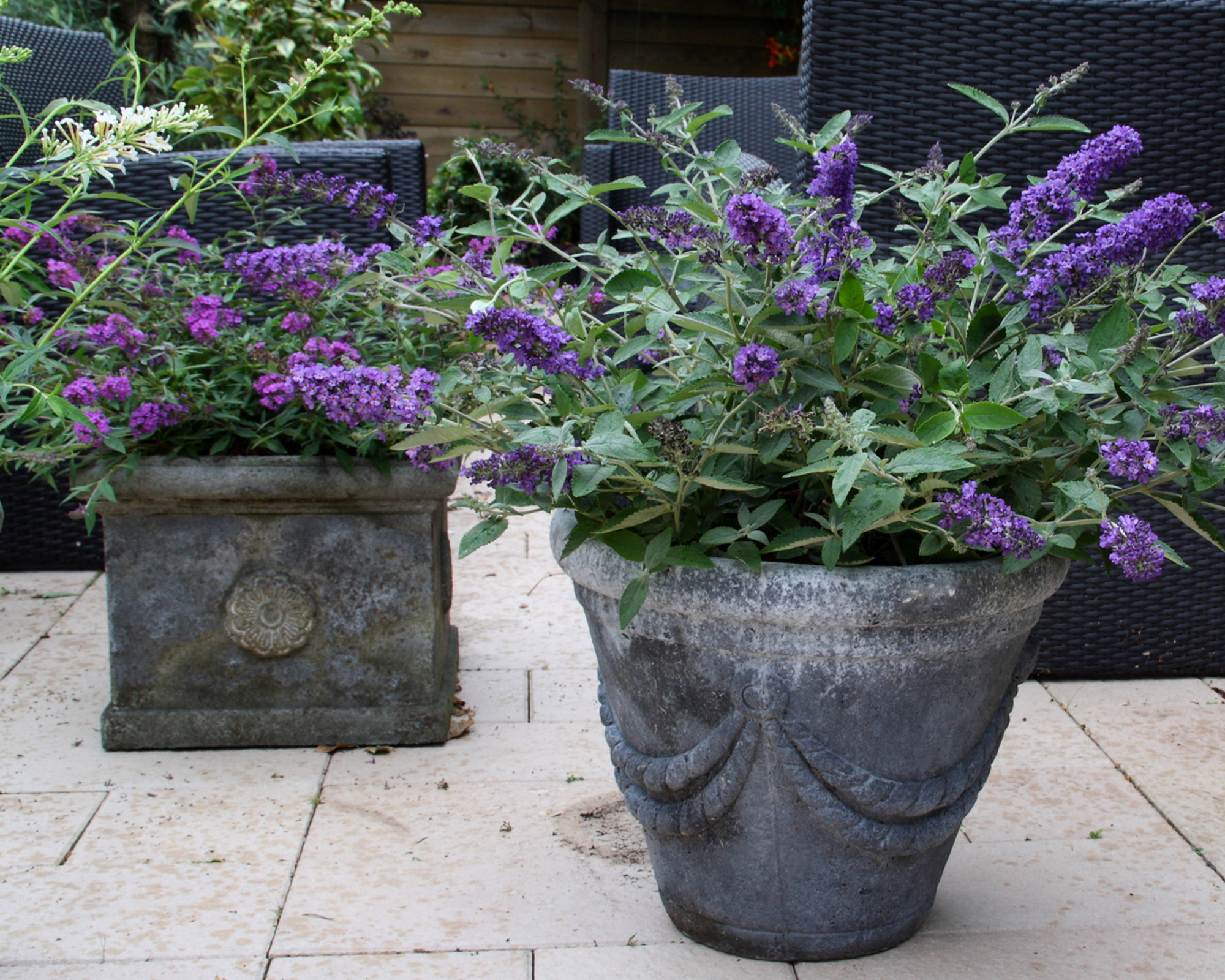
For containers, choose a modern variety bred to be compact, such as Flutterby Petite Blue Heaven
How to care for a butterfly bush
Once your butterfly bush is established, there are few things needed to keep it thriving. Buddleja make excellent low maintenance flowerbed edging plants and plants for the backs of borders, as their hardiness and drought resistance means regular watering isn’t always required.
The most important care that a butterfly bush needs is deadheading flowers. As soon as the flowers have turned brown, snip them off. Immediately behind the dead flower head, you will usually find a short shoot with a cluster of flower buds at the tip. Cut just above that shoot to spur it into opening its flowers.
Deadheading is important because it dramatically improves the look of the plant. The display from white-flowered varieties, in particular, is often ruined by the presence of the brown seed heads from the earlier flowers. Deadheading also prevents the plant wasting energy in producing seeds when it is the flowers that are important. So grab your best secateurs and keep on top of this important task.
Apart from that, there isn’t much to worry about. The only time you need to water a butterfly bush is during spring when the plant is growing freely. Otherwise, water sparingly and only if the ground is looking parched. Remember: dry soil isn’t necessarily a problem for this shrub. After planting, you also shouldn’t need to fertilize much, although a layer of aged compost each spring can lock moisture in and reduce weeds.
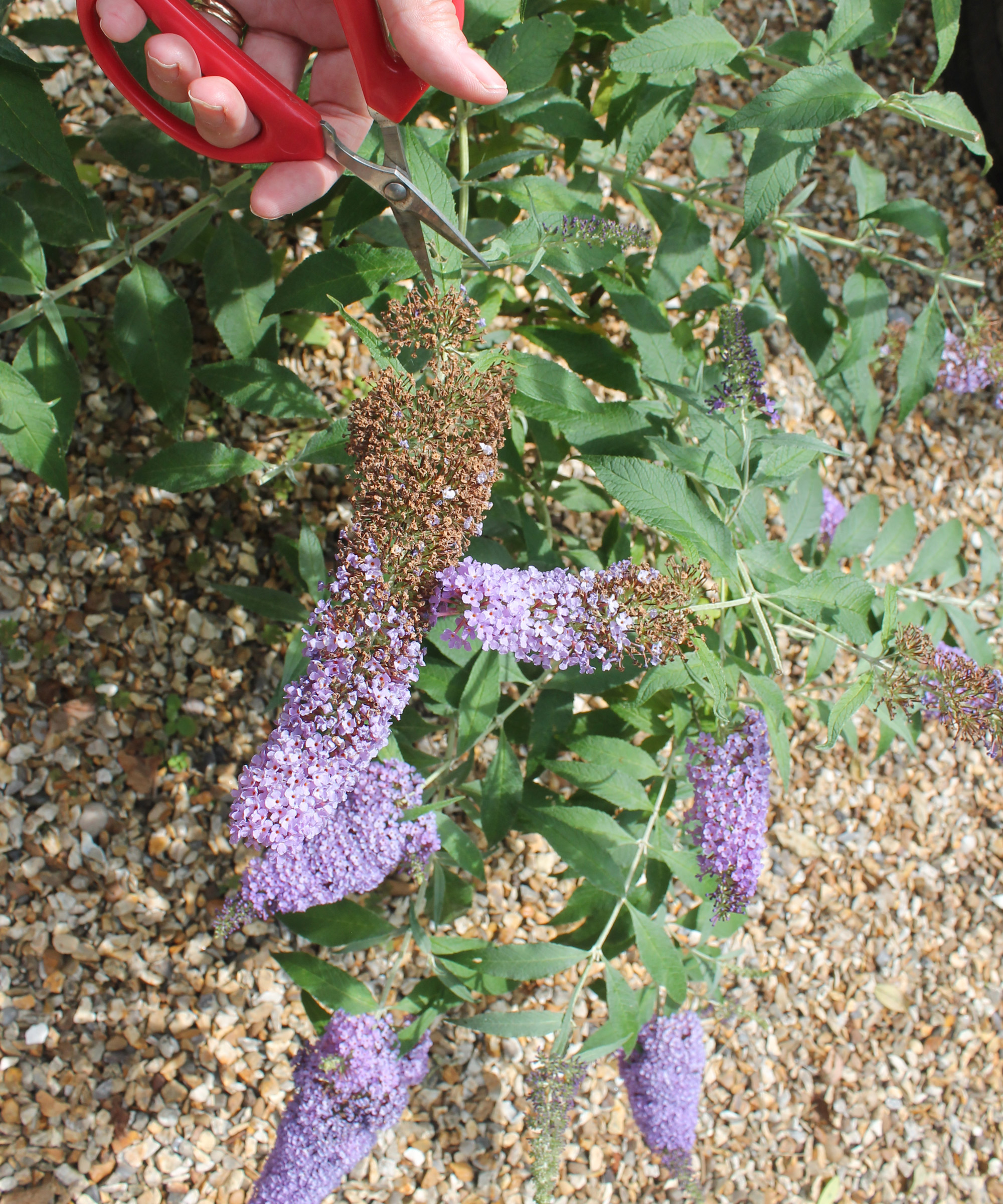
Deadhead your butterfly bush as soon as the flowers begin to turn brown
How to propagate a butterfly bush
Once you are happy with your butterfly bush, the good news is that it is easy to make more! You don’t have to grow flowers from seeds, either – you can make more plants from a named variety in your garden simply by taking cuttings in spring or summer. This style of propagation is an easy way of boosting the number of buddleja in your garden or gifting your friends with their own vibrant pollinating beauties.
You can take cuttings from plants in late spring. Just snip off the tips of the growing shoots for cuttings around 4-6in (10-15cm) long. Re-cut just below the lowest leaf joint, and remove the leaves on the lowest half of the cutting. This allows the cutting to direct its energy into the roots. Dip the stems in potting hormone. Then insert in a mix of horticultural sand and fresh potting compost, so the lowest leaves are just above the soil.
Cover with a clear plastic bag and keep in a light (but not sunny) place, and make sure you check frequently. You can move the cuttings into individual pots when roots start to emerge from the drainage holes. Plant out in late spring or early summer once they are making lots of new growth. Chances are you will have newly flowering shrubs within a year.
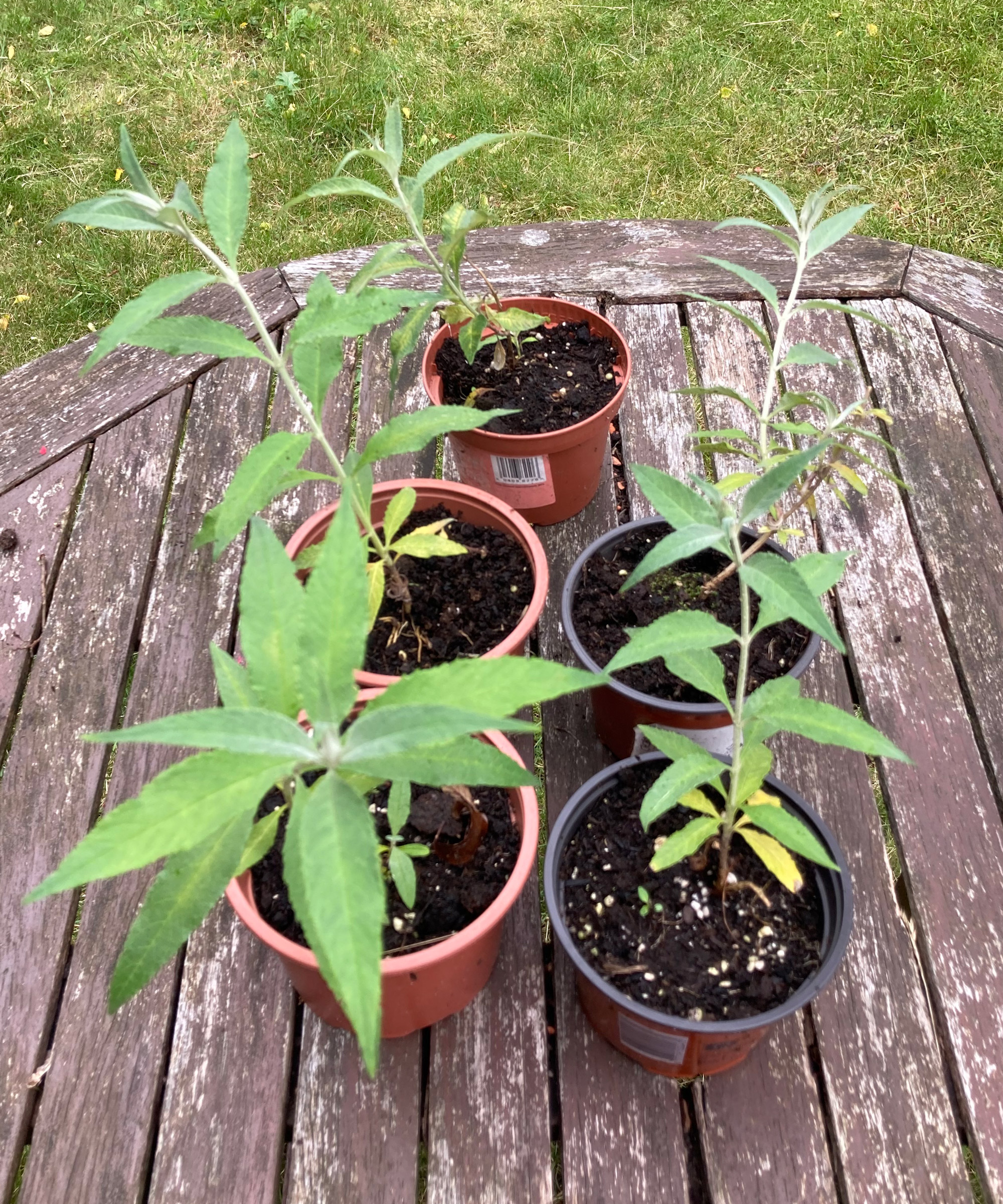
Cuttings root quickly and when large enough, you can transplant them into individual pots
Butterfly bush problems and how to solve them
The butterfly bush is a notably hardy shrub, and once established there aren’t many things likely to cause major issues. You might find that the trunks of particularly big plants may peel. If this happens, don’t worry, it’s quite normal.
We have also said that you don’t need to water your buddleja much – in fact, waterlogged soil can cause more damage than any pests or diseases. So while it can help to know the best time to water plants, take care not to overwater these shrubs and you should be fine.
That said, there is one time when hydration can come in very handy, and that is if you suspect that your buddleja has fallen foul of red spider mite. This is the most common pest to befall the butterfly bush. These mites can occur in long hot, dry periods. They produce a mass of webbing on plants, and tiny insects can be seen moving around amongst it. If you don’t know how to get rid of spider mites, don’t panic: just grab a hosepipe and give your buddleja a quick blast to dislodge these pests. Thorough irrigation that soaks roots is the best course of action.
Sometimes a mature plant will collapse when the roots are infected by a soil fungus, sadly removal of the plant is the only answer.
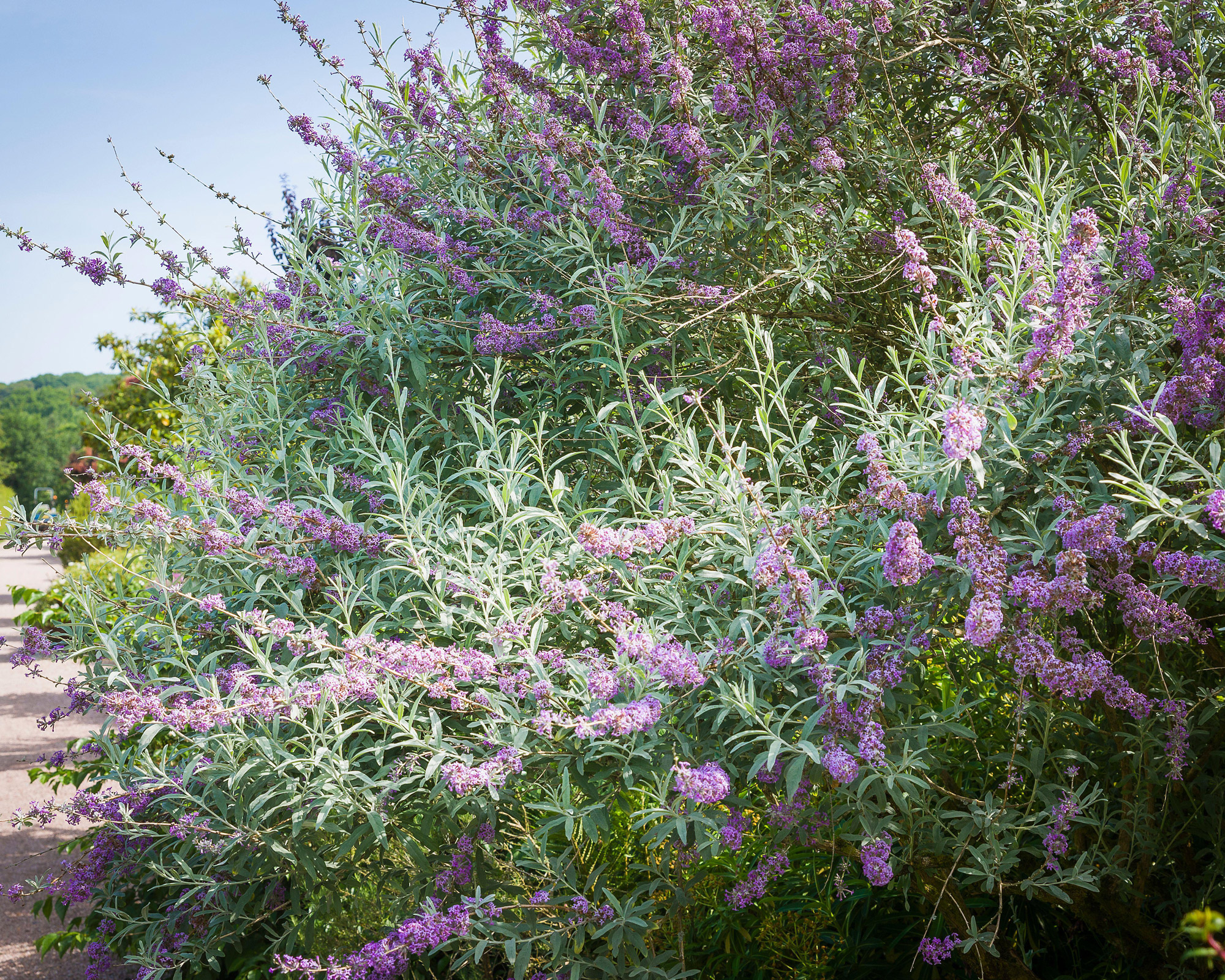
A large butterfly bush may get so big that the trunk starts peeling, but don’t panic - this is normal
Which butterfly bush attracts the most butterflies?
As well as being some of the best low maintenance shrubs to grow, buddlejas are one of the best plants for pollinators as their nectar makes them intensely attractive to both butterflies and bees. They make a popular nectar-rich cafe for species such as the red admiral, peacock, painted lady, comma, small tortoiseshell, brimstone, large and small white and meadow brown, amongst others.
However, it is fair to say that some buddleja are a little more intense than others. Buddleja davidii, B. globosa and B. x weyeriana varieties are said to be some of the best plants for butterflies. But here are some of our favorite butterfly bush options for guaranteeing a cloud of colorful butterfly action through summer:
- ‘Black Knight’: This buddleja hybrid is filled with a spray of tall magenta blossoms. Recipient of the RHS Award of Garden Merit (AGM), it develops an expected size and spread of 9-13ft (3-4m).
- ‘Pink Pagoda’: B. x weyeriana cultivars attract as many bees as butterflies, but are especially alluring to the small tortoiseshell and the monarch. This 5ft (1.5m) cultivar is also known as ‘Inspired Pink’.
- ‘Miss Ruby’: Pinky red blooms fill this compact shrub from spring to October, creating an impressive flowering season and, by extension, an excellent point of interest for butterfly activity. Grows to 3-6ft (1-2m).
- ‘Nanho Blue’: Rich plumes of violet blue flowers adorn this spectacular shrub, which is also called ‘Petite Indigo’. This butterfly bush only grows to 5ft (1.5m) high, making it suitable for any size of garden.
- ‘White Profusion’: This classic white AGM winner has long conical clusters of nectar-rich blossoms. As well as being highly appealing to butterflies, it also attracts bees and moths and other beneficial insects.
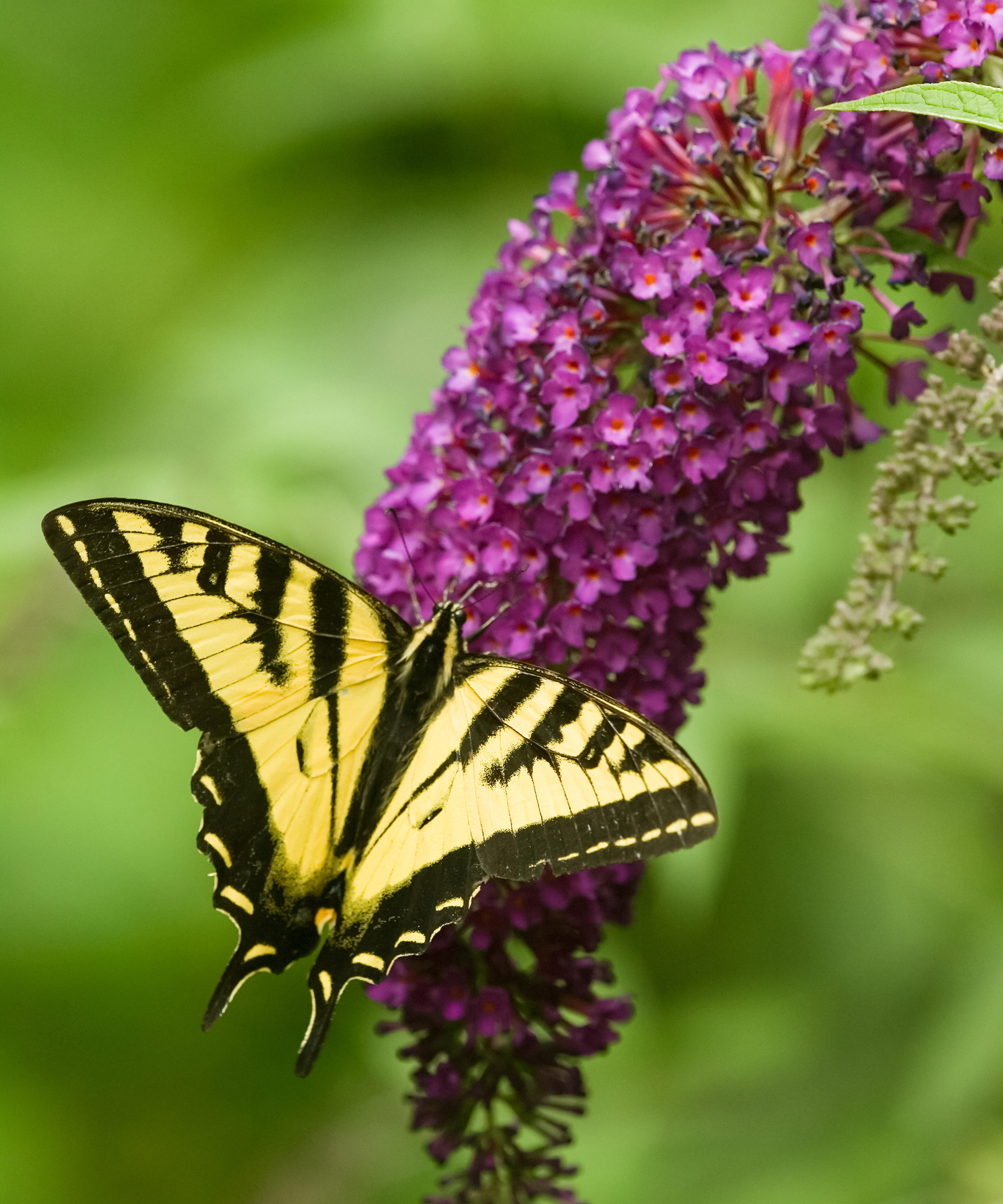
'Black Knight' is a robust hybrid that attracts the Western Tiger Swallowtail butterfly
Should a butterfly bush be cut back every year?
The butterfly bush has a bit of a reputation for ballooning once it is properly established. If you are looking for the best shrubs for small gardens, size will be an important consideration. It’s smart to manage your buddleja so it doesn’t become unwieldy and hard to maintain. Having a basic understanding of the principles of pruning shrubs can help you here, and a few sensible cuts made regularly will be a lot less onerous than having to make radical cuts when things are out of control.
Butterfly bush produces its summer flower spikes on growth that develops earlier the same season. So, to encourage the most growth and the most flowers, pruning buddleja is done in spring, just as the buds on the old branches are starting into growth.
Some gardeners prune very hard, cutting off all growth to about 6-12in (15-30cm) above the base. The result is relatively few, very vigorous, fast growing shoots carrying long fat spikes of flowers.
Pruning less severely, to about 2-3ft (60-90cm) will encourage far more shoots to develop, creating a bushier look, with many more, but smaller, flower spikes.
'Many people cut their butterfly bush back in autumn, as part of their fall clean up,' says the experts at Proven Winners. 'But particularly in cold climates, this can leave your butterfly bush more susceptible to damage over winter. Do not prune until you see green buds on the stems. Make your cuts just above where big, healthy leaf buds have formed. It can take several weeks into spring for new growth to show up - be patient and resist the urge to cut them back too early.'
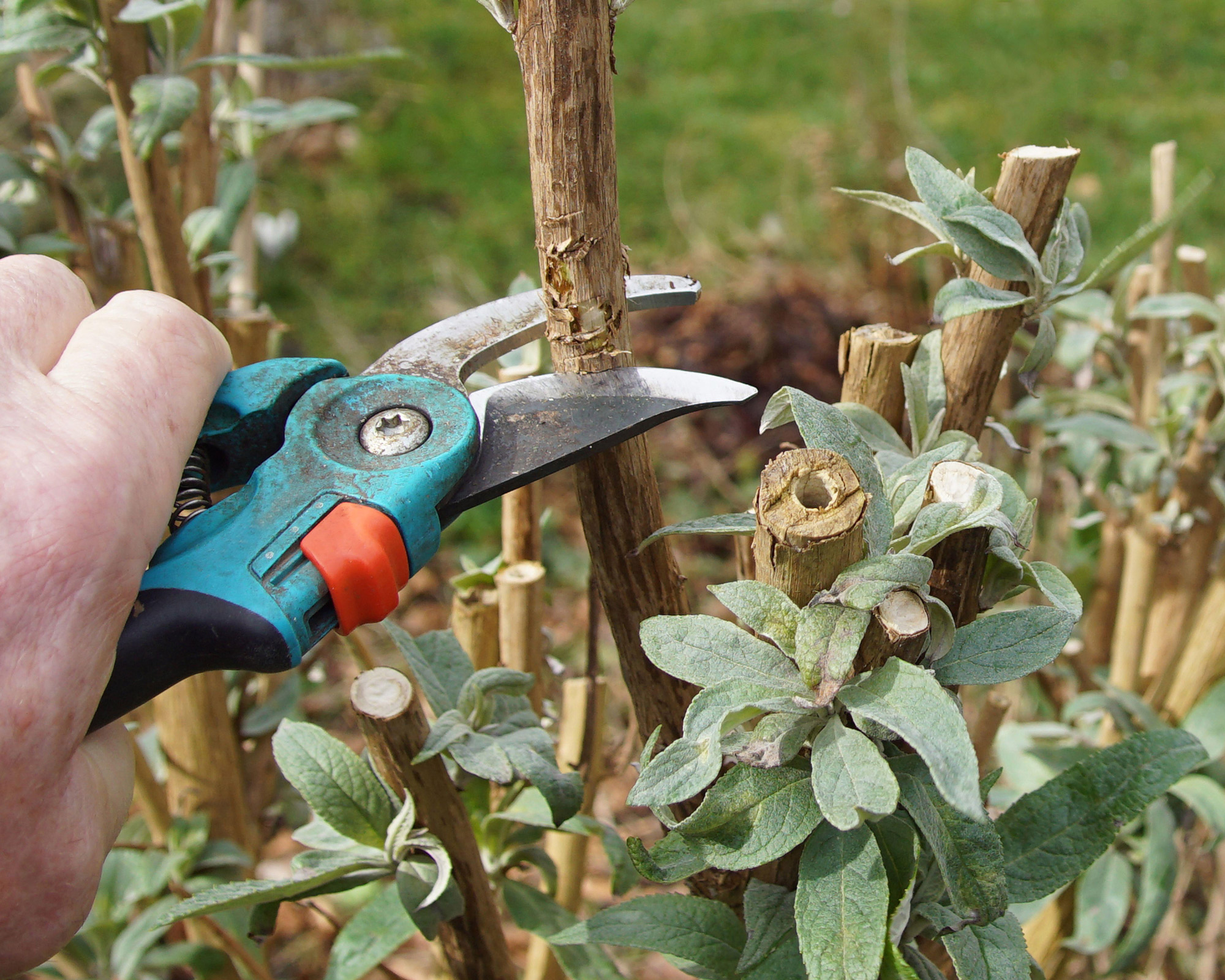
More conservative spring pruning to to 2-3ft (60-90cm) encourages bushy growth
Are all kinds of butterfly bush invasive?
No, not all varieties of butterfly bush are considered to be invasive plants. Many old fashioned varieties of the butterfly bush are invasive in areas where winters and springs are warm enough for the plants to overwinter successfully and for seeds to sprout in the spring, but many modern varieties are different.
Entomology expert Debbie Hadley explains: 'Just when you were getting ready to compost your butterfly bushes for good, horticulturalists found a solution to the problem. Buddleia breeders produced cultivars that are, in effect, sterile. These hybrids produce so little seed (less than 2% of traditional butterfly bushes), they are considered non-invasive varieties. The State of Oregon, which has a rigorous ban on buddleia in place, has recently amended their ban to allow these non-invasive cultivars. Seems you can have your butterfly bush and plant it, too.'
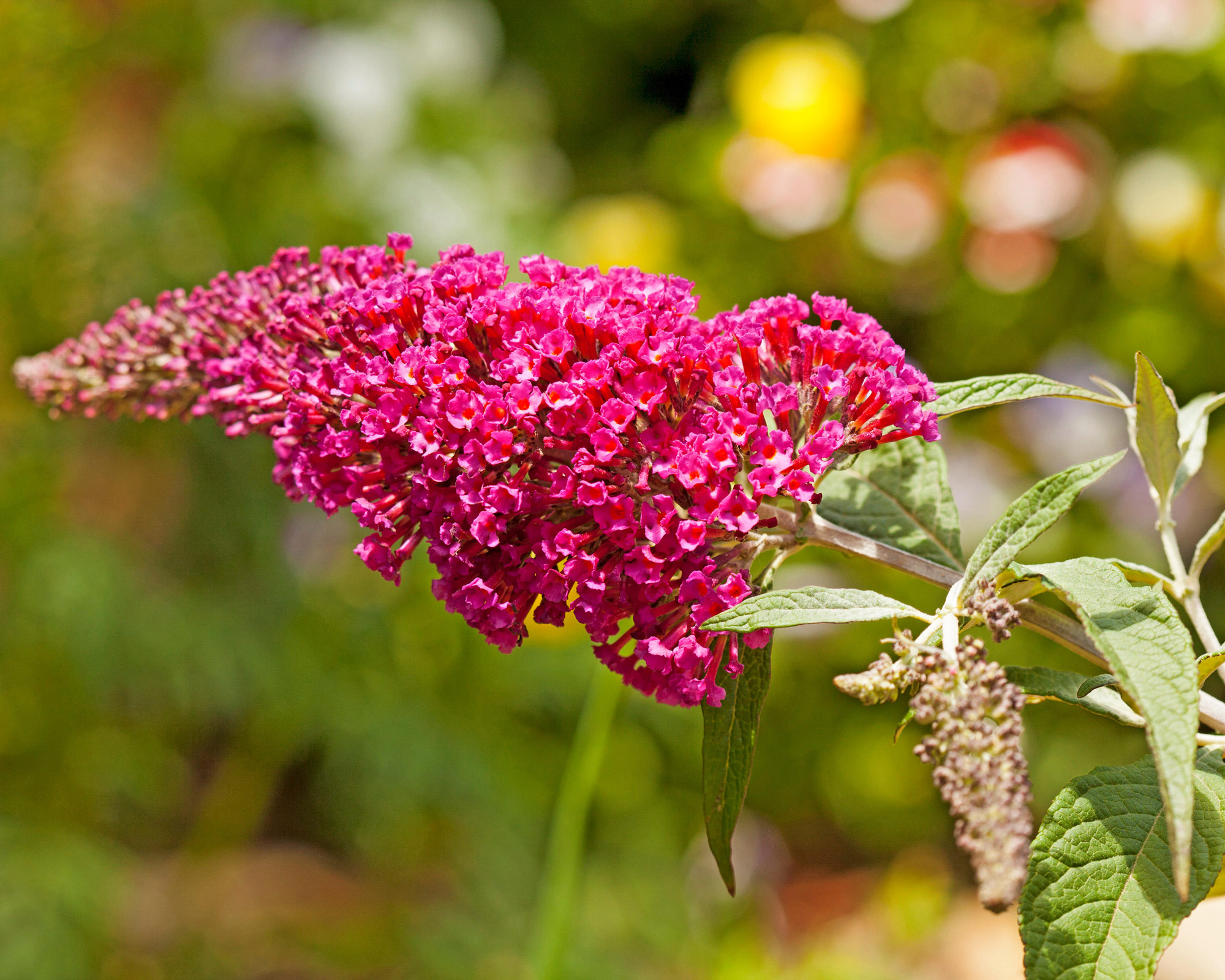
Buddleja Buzz Series ‘Velvet’ is an old-fashioned variety and so can be quite invasive
Are butterfly bushes deer resistant?
Butterfly bushes are not 100% guaranteed deer resistant plants, but the experts at the New Jersey Agricultural Experiment Station rate butterfly bush as 'Rarely Damaged'. Deer prefer most other plants and will only feed on butterfly bushes as a last resort.
Where to buy a butterfly bush
All kinds of butterfly bush are sold in bud or in bloom at garden centers and retail nurseries. You can get plants in pots ranging from quarts to three gallons. They are also sometimes offered earlier in the season.
Buddleja are also available by mail order and are usually offered in tubes or quarts to reduce shipping costs. Mail order suppliers offer a wide selection of flower colors, shapes and sizes, ranging from compact to scopic, making it easy to choose the right butterfly bush for you.
Whether you want something for a modern garden or an old-fashioned cottage garden or meadow style, there is a butterfly bush for every taste. You can also acquire packs of seed, although the quality of the resulting plants can be less reliable. Use our quick links to find varieties for your garden.
Where to buy butterfly bush seeds and plants in the US:
- Shop butterfly bush plants and seeds at Burpee
- Shop butterfly bush plants and seeds at Forest Farm
- Shop butterfly bush plants and seeds at Garden Crossings
- Shop butterfly bush plants and seeds at Home Depot
- Shop butterfly bush plants and seeds at Monrovia
- Shop butterfly bush plants and seeds at Proven Winners
- Shop butterfly bush plants and seeds at White Flower Farm
- Shop butterfly bush plants and seeds at Walmart
Where to buy butterfly bush seeds and plants in the UK:
- Shop butterfly bush seeds at Amazon
- Shop butterfly bush plants and seeds at Crocus
- Shop butterfly bush plants and seeds at Dobies
- Shop butterfly bush plants and seeds at Mr Fothergill’s
- Shop butterfly bush plants and seeds at The Lavender Garden
- Shop butterfly bush plants and seeds at Marshalls
- Shop butterfly bush plants and seeds at Suttons
- Shop butterfly bush plants and seeds at Thompson & Morgan

Graham Rice is a garden writer who has won awards for his work online, and in books and magazines, on both sides of the Atlantic. He is a member of a number of Royal Horticultural Society committees and the recipient of the 2021 Garden Media Guild Lifetime Achievement Award.
